
10 ideas to combine asters
For a colourful and bright flowerbed!
Contents
Asters are perennials that brighten up autumn with their colourful flowering! Aster novi-belgii and Aster novae-angliae easily fit into mixed borders alongside, for example, yarrow or grasses. Some are more suited for rock garden planting, such as Aster alpinus, while others are perfect for edging, like Aster dumosus. The tallest asters have a light and airy quality, quite natural. They are ideal for accompanying grasses, such as Miscanthus, Stipa, or Pennisetum, and integrate easily into naturalistic flower beds! In contrast, the more compact varieties will bring a lot of colour to the edges of beds. Planted in pots, they allow for beautiful floral compositions. Follow our tips and discover in detail how and with which plants to associate asters.
In a border or mixed border
Asters pair wonderfully with other perennials and bushes to create colourful flowerbeds. Place some bushes at the back of your flowerbed, and in front of them, clumps of hardy geraniums, sages, or grasses. Asters are perfect for complementing the vibrant flowering of dahlias! Plant the most compact asters (for example, Aster alpinus) in the foreground or at the edge of the flowerbeds. Conversely, use the taller varieties to add volume at the back of the flowerbed (but remember to stake them!). You can create a stunning scene with Aconitum carmichaelii ‘Arendsii’, whose blue flowers harmonise beautifully with those of Aster ‘Violet Queen’. The grasses, Miscanthus and Calamagrostis, add more lightness and volume to this picture. Kniphofias add a graphic and structural element.
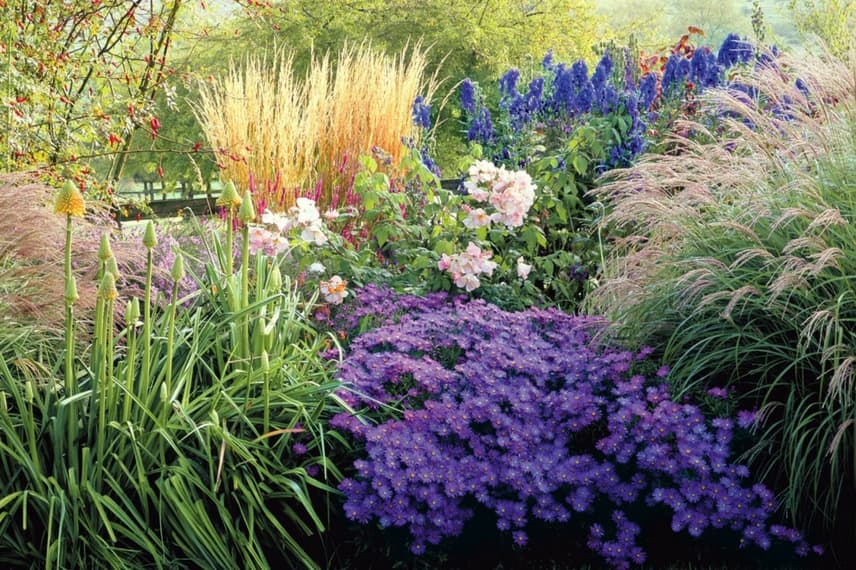
Aster ‘Violet Queen’ with Aconitum carmichaelii ‘Arendsii’, Miscanthus, Calamagrostis, Kniphofias…
Read also
Choosing, planting and caring for astersOn the edge
Use asters to bring colour and beautifully highlight the edge of a path. They are excellent border plants! Choose compact varieties, such as Aster dumosus or Aster alpinus. Avoid those with excessive growth. Enjoy the vibrant pink flowering of Aster dumosus ‘Jenny’. For a softer flowering, you can choose Aster amellus ‘Rosa Erfüllung’, which blooms in summer. Pair them with some perennials, such as heucheras, salvias, bergenias, lavenders, hardy geraniums…

Geranium ‘Rozanne’, Aster amellus ‘Rosa Erfullung’, Heuchera ‘Sugar Plum’
Discover other Asters
View all →Available in 1 sizes
Available in 0 sizes
Available in 2 sizes
Available in 2 sizes
Available in 1 sizes
Available in 1 sizes
Available in 0 sizes
Available in 1 sizes
Available in 1 sizes
Available in 1 sizes
In rockery
Asters thrive in sunny, well-drained situations, so you can take advantage of this to brighten up rockeries. Choose the most compact varieties. Aster alpinus is perfect for this situation, offering stunning blue-mauve flowers in spring. For spring flowering, you can also opt for Aster tongolensis, while for summer flowering, you should favour Aster amellus. Plant alongside them some clumps of yarrow, such as Achillea tomentosa. You can combine them with euphorbias, lavenders, and carnations (notably Dianthus deltoides). Install some clumps of sedums at the edge. They will perfectly accompany the autumn-flowering asters. Also, enjoy Delosperma, which will form carpets of star-shaped flowers in vibrant colours. To structure the rockery, plant small conifers.

Sedum album, Aster amellus ‘September Glow’, Dianthus deltoides
Read also
Asters : growing and careFor a naturalistic border
With their airy flowering and lightness, asters easily find their place in a naturalistic border. Avoid Aster novae-angliae, with their overly bright flowers and dense habit, but opt for tall varieties with small flowers. For example, choose Aster ‘Monte Cassino’, which has countless small white flowers, creating a delicate, airy effect reminiscent of the flowering of gypsophila. Also discover Aster ‘Ann Leys’ with its surprising purple and green flowering. Pair them with large perennials: enjoy the yellow and airy flowers of Solidago, or the pink and light flowering of Eupatorium. Achilleas also fit easily into this style of garden. For graphic appeal and lightness, add clumps of grasses: they are perfect for accompanying asters!
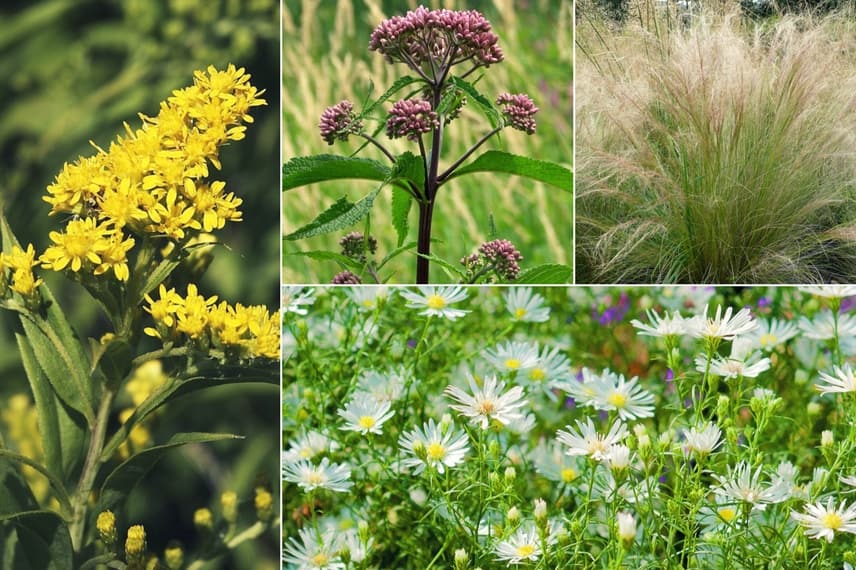
Solidago gigantea, Eupatorium maculatum (photo D. Gordon E. Robertson), Stipa tenuifolia, Aster ‘Monte Cassino’
In woodland
Although most Asters thrive in sunlight, theAster divaricatus creates a beautiful woodland scene! This is a botanical species that has a very wild and natural aspect. Its white flowering will bring brightness to a shaded garden! You can also choose Aster macrophyllus ‘Albus’, which tolerates light shade and will thrive under deciduous trees. It has large leaves and a generous white flowering. These asters pair wonderfully with Japanese Anemones. Enjoy the lightness of Luzula, which will form a beautiful carpet of fine foliage, or the graphic quality of ferns. You can plant periwinkles to cover the ground with lovely blue or purple flowers in spring.
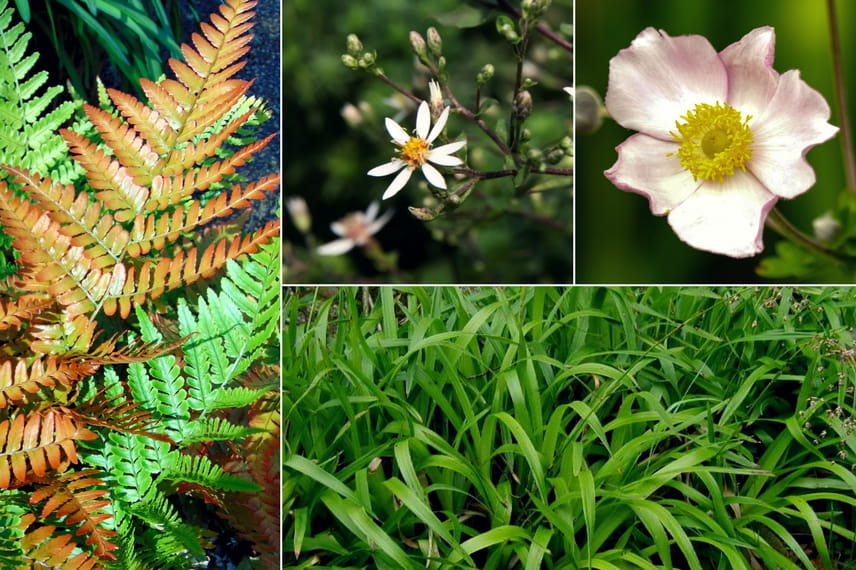
Dryopteris erythrosora, Aster divaricatus (photo David J. Stang), Anemone japonica ‘Robustissima’, Luzula sylvatica
With grasses!
Asters pair wonderfully with ornamental grasses, creating a very wild and light flowerbed that gives a beautiful effect of a wildflower field! Combine the graphic nature of the grasses with the colourful and airy flowering of asters to achieve a scene that is both natural and delicate. Preferably choose stipas, pennisetums, or miscanthus. For example, you can pair the blue-purple flowering of the Aster ‘Professor Anton Kippenberg’ with the lightness of the grass Stipa tenuissima.
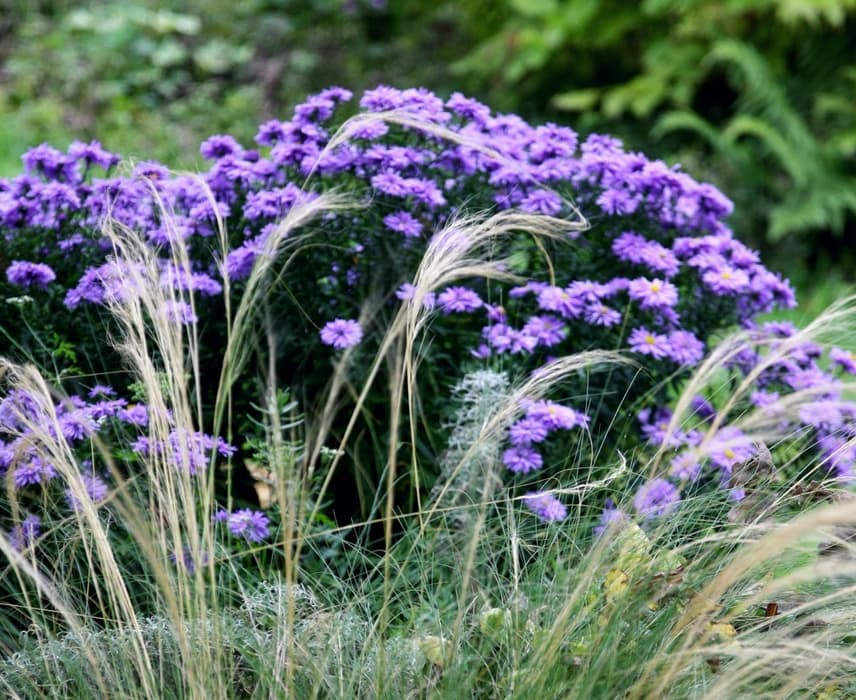
Aster Prof. Anton Kippenberg and Stipa tenuissima
For a beautiful autumn atmosphere
Asters create a stunning autumn scene. They find their place in an autumn border with soft and warm tones, where red, orange, pink, or purple dominate. Structure the back of the border with some bushes: for example, you can take advantage of Callicarpa bodinieri ‘Profusion’, a bush that bears numerous purple berries in autumn. Plant some clumps of asters in front, such as Aster novae-angliae ‘Septemberrubin’, which offers a beautiful pink-red flowering. They will wonderfully accompany the light flowering of Buenos-Aires verbena (Verbena bonariensis), that of purple coneflowers (Echinacea purpurea), Sedum spectabile, or Perovskia atriplicifolia.
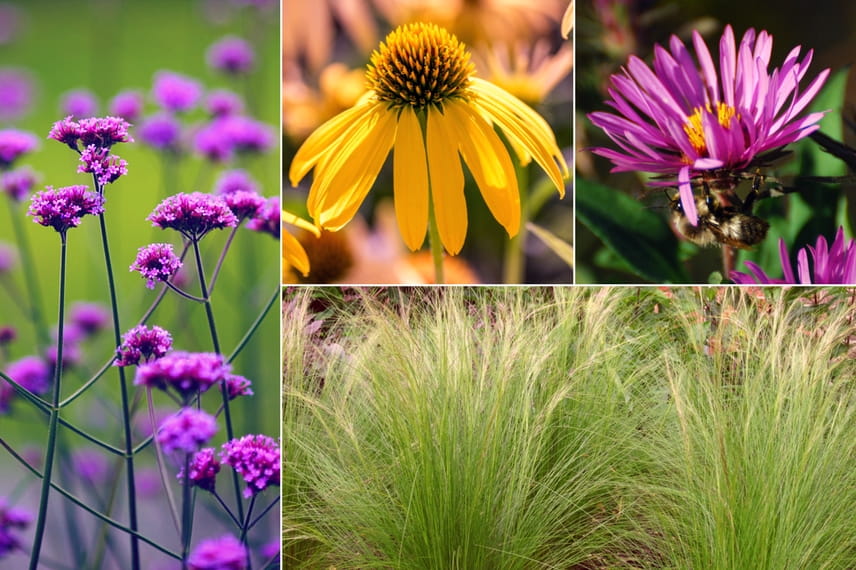
Verbena bonariensis, Echinacea purpurea ‘Summer Breeze’ (photo Valleybrook Gardens), Aster novae-angliae ‘Constanz’ (photo Joshua Mayer), Stipa tenuifolia
With roses!
Feel free to use asters to add volume and colour at the base of a rosebush, thus dressing it up beautifully. The Aster lateriflorus ‘Horizontalis’, with its spreading habit, is particularly suited for this purpose! You can enjoy the delicate and elegant shades of Aster ageratoides ‘Asran’ and the rose ‘Lichfield Angel’ to create a romantic atmosphere! For a slightly more colourful scene, choose Aster amethystinus ‘Kilye’ and the rose ‘Rose of Hope’. You can also take advantage of the blue flowering of Aster ‘Freiburg’ and the elegant apricot-coloured flowers of the rose ‘Grace’.
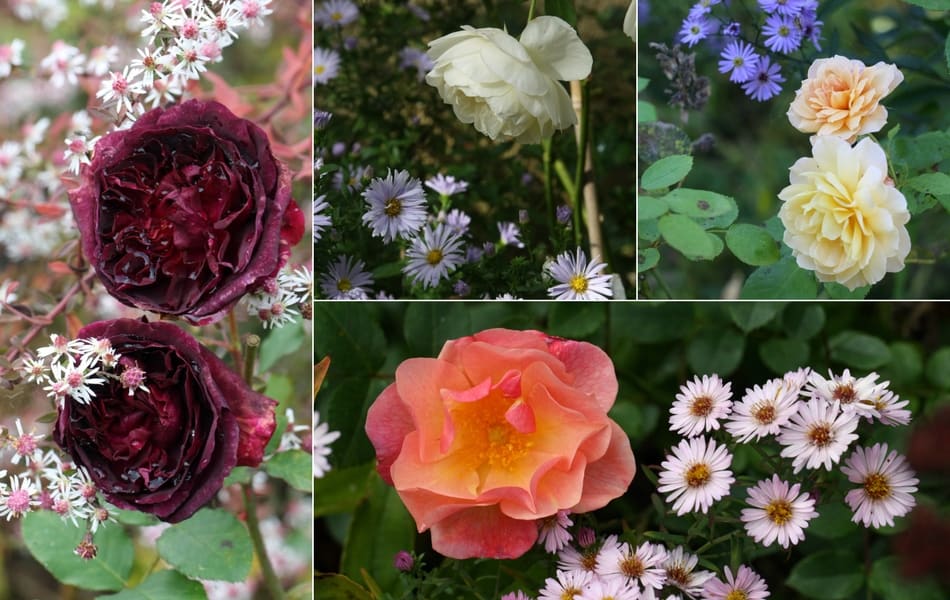
On the left, rose ‘Munstead Wood’ and aster ‘Lady in Black’ – Top left, rose ‘Lichfield Angel’ and aster ‘Asran’ – Top right, rose ‘Grace’ and aster ‘Freiburg’ – Bottom right, rose ‘Rose of Hope’ and aster ‘Kilye’
With decorative or colourful foliage
To highlight their flowering, you can place asters in front of darker foliage, such as that of Cotinus ‘Royal Purple’, or by installing, for example, Aster ‘Professeur Anton Kippenberg’ in front of a heuchera ‘Palace Purple’. The starry and bright flowering of asters will create a superb contrast with this darker and more massive foliage. Take advantage of the late flowering of asters to pair them with foliage that takes on beautiful autumn colours, such as Hydrangea quercifolia. You can, for example, place Aster ‘Vasterival’ alongside Hydrangea quercifolia ‘Burgundy’. Also discover the colourful foliage of Cornus florida ‘Cherokee Sunset’, which takes on a lovely pink/orange hue in autumn.
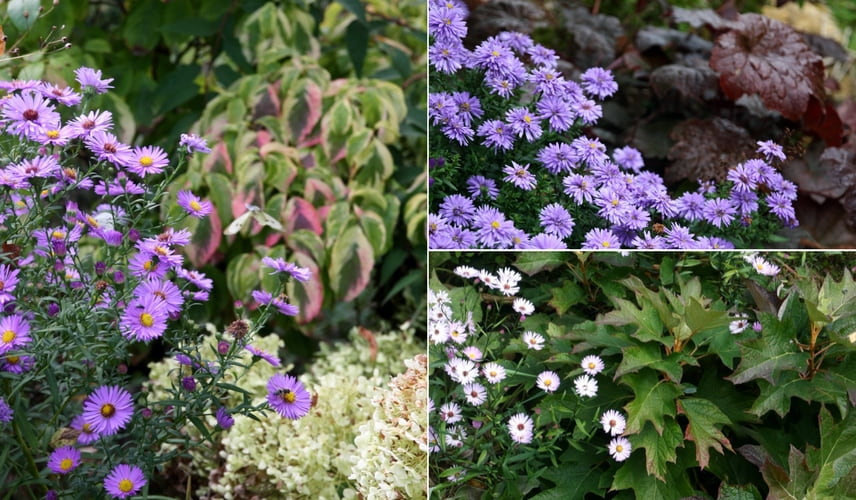
On the left, Cornus florida ‘Cherokee Sunset’ and Aster – Top right, Heuchera ‘Palace Purple’ and Aster ‘Prof. Anton Kippenberg’ – Bottom right, Hydrangea quercifolia ‘Burgundy’ and Aster ‘Le Vasterival’
In a container or planter
Make the most of asters to brighten up your balconies and window sills. Choose the most compact varieties, such as Aster alpinus or Aster dumosus. For example, discover the blue-purple flowering of Aster dumosus ‘Augenweide’. Create stunning arrangements by pairing them with grasses (for instance, Carex comans), ivy, or chrysanthemums for autumn-flowering asters (like Aster dumosus).

Chrysanthemum indicum ‘Dernier Soleil’, Carex comans, ‘Milk Chocolate’ and Aster dumosus ‘Augenweide’
- Subscribe!
- Contents































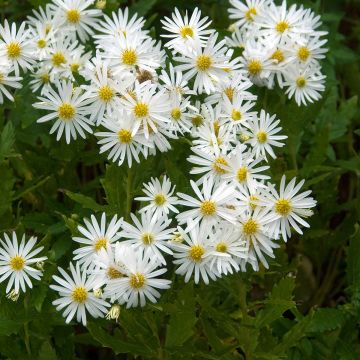
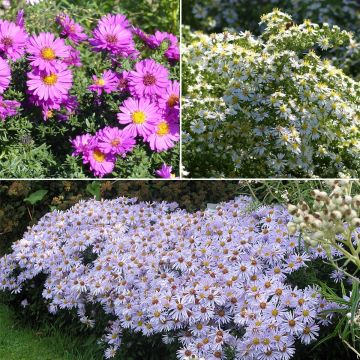
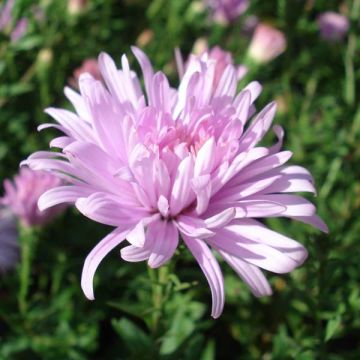
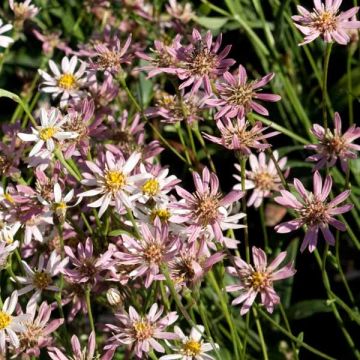
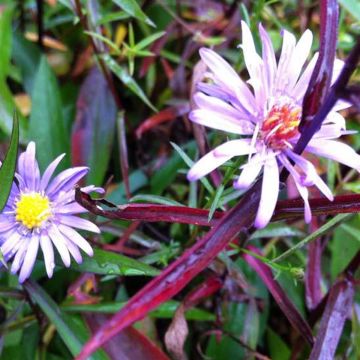
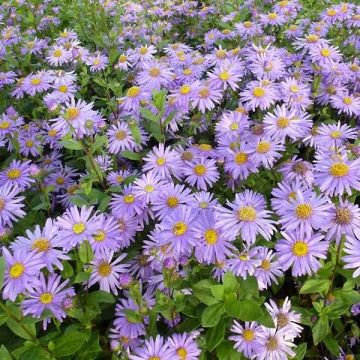
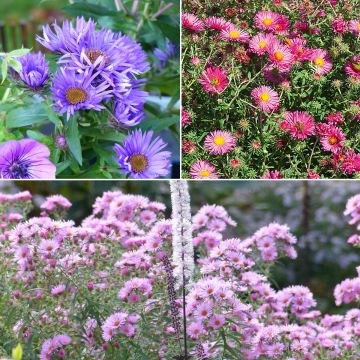
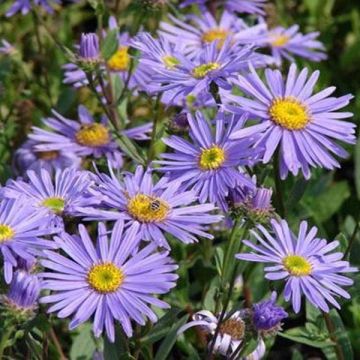
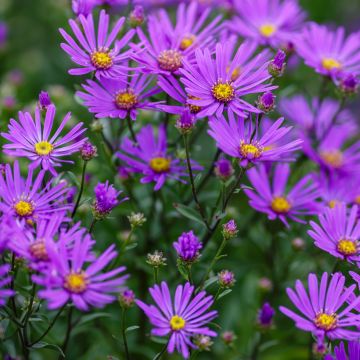
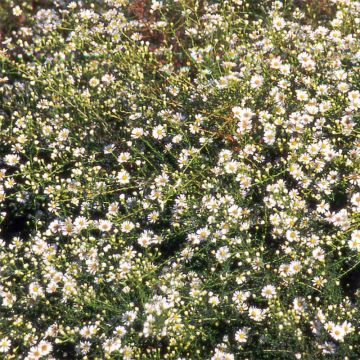
Comments